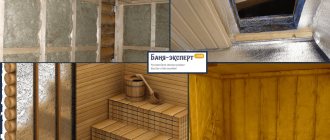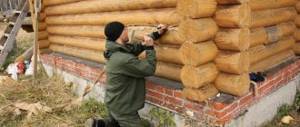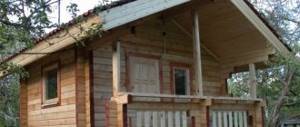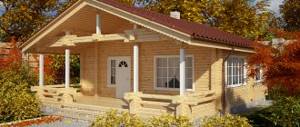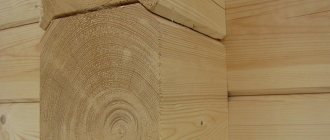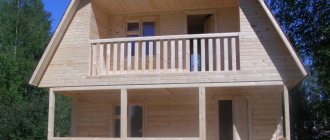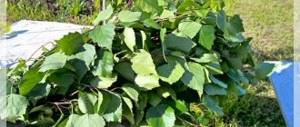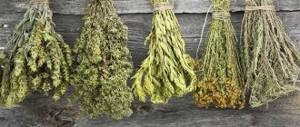The operating mode of a bathhouse differs from the maintenance of residential buildings. Most of the time, the bathhouse is not heated; if necessary, the interior space is heated to a temperature that allows you to steam, shower and be without outer clothing. The locker room should warm up to 25 degrees, the dressing room - to 27-29 degrees, these conditions are higher than the requirements for the maintenance of residential premises. In the steam room the temperature reaches 100 degrees or more.
The costs of heating a bathhouse and maintaining a comfortable temperature depend on the size of the building, building material and the effectiveness of insulation. Insulation is done in stages, divided into external and internal, and a separate insulation circuit is made in the steam room. Experts recommend: in a bathhouse made of timber with a cross-section of less than 180x180, internal insulation must be done. The decision on how to insulate a timber bathhouse from the inside and what material to use is made depending on the specific conditions.
When to start insulation and finishing work in a new wooden bathhouse
If the bathhouse is made of timber or is a log house, then you must immediately keep in mind that in the first three years after construction it will shrink noticeably (then less). On average, this is 20 cm in the first 3 years.
During shrinkage, cracks form - all this time you will be patching them. And the most important thing: if finishing was carried out immediately after construction, and it was nailed down firmly, then the lathing will not allow the bathhouse to sit properly.
Therefore, it is either left unfinished, or grooves are cut out in the sheathing so that the nails gradually slide into the grooves.
It’s better not to finish it, because you have to caulk the cracks both inside and outside, and the sheathing will get in the way. The bathhouse needs to be allowed to shrink (at least) for one year. And when its results are already visible, you can think about insulation and finishing work.
Inter-crown insulation and sealing of cracks
Over time, wooden buildings inevitably shrink, which causes gaps to appear between the crowns. Those, in turn, open the way for drafts, so the first stage of the fight is to seal them.
The initial stage of interventional insulation occurs during construction. Timber (including profiled) and round timber are laid with tow tape or jute. Subsequently, this will be internal interventional insulation.
In addition to the internal, there is also an external one, which has to be periodically updated. The resulting cracks can be filled with tow, jute, natural moss, or you can use modern materials, but only those designed for wood.
IMPORTANT! Plumbing sealants, putty and polyurethane foam are not suitable for sealing cracks in a bathhouse made of logs or timber. They are inelastic, designed for a constant gap size (while wood changes), they have poor adhesion to wood, insufficient heat resistance, harmful emissions, etc.
flaws. Over time they crumble out of the cracks
They are inelastic, designed for a constant gap size (and in wood it changes), they have poor adhesion to wood, insufficient heat resistance, harmful emissions and other disadvantages. Over time, they crumble out of the cracks.
The cracks on the outside of the beam or log are sealed with wood sealants in such a way that the sealants will dry from 2 to 5 weeks, and the walls must be protected from the sun and rain during this time.
External insulation
Wooden structures
The process of thermal insulation of the room in which the bathhouse is located can be divided into two stages - external and internal work (see also the article Insulation of a bathhouse - materials and technologies). Below we will look at how to insulate a bathhouse made from different materials, and we will start, naturally, with the traditional option - a wooden frame.
By and large, wooden baths and saunas were previously not insulated at all. That is, to maintain maximum temperature in them, no additional structures were erected.
However, it is still possible to improve the heat-saving characteristics of a wooden log house:
The main source of heat loss is the gaps between the crowns of the bathhouse
It doesn’t matter whether the frame is made of round timber or timber, over time the wood will dry out and the gaps between the elements will reach several millimeters
We caulk the crowns
- To reduce heat loss during the construction of the bathhouse, we lay a special insulation between the crowns.
- Six months after construction (ideally, the bathhouse is not in use at this time), we additionally caulk all the cracks. To do this, you can use tow, moss or special materials.
- To seal cracks, use a hammer and a special spatula - “caulk”.
Brick structures
Brick baths are easier to insulate, although more expensive thermal insulation materials are used.
- When choosing how to insulate a bathhouse from the outside, many people prefer cheap polystyrene foam, although it is still better to use polystyrene foam boards. Although they are more expensive, they are more durable and durable.
- Before starting insulation, we prime the wall and then install the lower guide profile. We fasten polystyrene slabs on top of the brickwork with plastic dowels, after which we glue the seams with polyurethane foam.
- We glue fiberglass glass onto the polystyrene foam lining, after which we plaster the bathhouse.
Possible external insulation scheme
This method is the simplest, and it is the one that is used most often when doing all the work with your own hands. However, this is not the only technology, and if time and finances allow, you can even install a multi-layer ventilated facade - a diagram of its design is given above.
Materials
On the modern market there is a large number of insulating materials for interior work, with different raw materials and costs.
Traditional
Natural, environmentally friendly sealants are still used in the outback. They have been used to insulate wooden baths and other buildings for hundreds of years.
Such natural materials include:
- flax tow;
- felt;
- moss.
Natural raw materials do not last very long; If it is mainly birds who like to take it away from the outside, then from all sides of the log house the natural seals are attacked by rodents, insects, microorganisms, and fungi. To some extent, impregnation with an antiseptic helps to save the situation. In general, the procedure for insulating a wooden bathhouse with these materials takes a lot of time and gives short-lived results.
Modern
It is more convenient to use mineral wool and synthetic polymers to insulate a wooden bath; they last much longer.
Among artificial insulation for steam rooms, the following types are most popular:
- regular foam;
- extruded polystyrene, which is better known as penoplex;
- expanded polystyrene roof slabs;
- expanded clay flooring materials.
Any type of heat-insulating product must be resistant to ignition, have low thermal conductivity, high heat capacity, and mechanical strength. It is desirable that the insulation be resistant to microbes and atmospheric influences. In all these parameters, mineral wool and expanded clay occupy a high place.
Insulation of a brick bath
To begin with, it should be noted that building a brick bathhouse is much cheaper than building a wooden bathhouse. Based on this, many steam room lovers build a bathhouse from this material. However, you need to know that a brick bathhouse requires not only high-quality insulation, but also additional processing that protects the structure from the effects of water, steam and temperature changes.
The outside of the bath is insulated using various mineral wool insulation materials. This type of insulation is most often sold in rolls, slabs and mats. Rolled mineral wool insulation is used to cover the entire outer surface of the bathhouse walls. It is attached using ordinary wooden planks and slats. If the bathhouse is insulated using slabs, then metal corners should be installed between them, which must match the dimensions of the slabs.
When starting work, you need to take into account that not only the surface of the walls of the bathhouse, but also the entire perimeter of the foundation requires insulation. The finishing on top of the insulation is made from the material preferred by the bathhouse owner
At the same time, a small gap must be maintained between the insulation layer and the external finish - during operation it will serve as ventilation.
In order for the bathhouse to serve for a long time and fully insulate the roof of the building. This is most often done using clay or grass turf. The clay is diluted with water to the state of liquid sour cream and pour a thin layer over the roof surface. After waiting for the first layer to dry completely, pour in the second layer of clay mortar. Then the clay is carefully compacted and covered with material that has high thermal insulation characteristics, for example, sawdust. Tiles are laid on the floor of a brick bathhouse. Additional insulation of the floor is not required - the tile heats up quickly and retains the temperature perfectly.
Characteristics of eco-friendly building materials for the bath complex
Tow is a cheap and widespread thermal insulation building material for thermal insulation of bathhouses. This building material is made in the form of a tape, which is rolled into a roll. The use of rolled material greatly simplifies operations for insulating bath rooms, which saves a huge amount of time.
The main disadvantage of this building material is its fragility, as a result of which periodic replacement of building materials and repair of seams and joints between beams is required. A more modern version of the material is tarred tow. This building material is resistant to adverse environmental influences.
Ecowool is an environmentally friendly insulating building material. The thermal insulator is ideal for creating a heat-insulating layer for bathhouse walls, as it has a high degree of resistance to high humidity. The use of this material allows you to stabilize the humidity level in the bathhouse, thereby creating a special microclimate in the steam room. The insulation is capable of very quickly passing excess moisture through itself, and in case of its deficiency, this material is capable of releasing moisture back into the atmosphere of the steam room. This property allows you to regulate the humidity level in the bath room.
Jute is a mixture of flax fibers and jute. This building material is called flax wool. The main advantage of this building material is its high density. Thanks to this property, the thermal insulating building material can easily be installed in inter-crown joints.
Jute is subject to any type of processing and is resistant to biopests. This building material is not subject to rotting processes. This building material is also not exposed to elevated temperatures. Today this is one of the popular ones used for installing insulation in a bathhouse.
The next environmentally friendly material used to create thermal insulation in a bathhouse is moss. This building material has high thermal insulation properties, but this material has a significant drawback - it is difficult to work with.
To insulate a small room using this material, you will have to spend at least 3-4 days. When using other materials, it will take 1-2 days to insulate the bath.
The disadvantage of this building material is also that it is susceptible to being eaten by various insects. For this reason, when using moss, special attention is required to the insulation and its additional treatment with special compounds that prevent the appearance of insects in it.
The main advantage of insulating building materials is its absolute environmental safety and naturalness.
Insulation of a bathhouse made of timber from the outside
External insulation of walls made of timber simultaneously performs the functions of wind and moisture protection:
- First, caulking is done, and the walls are treated with an antiseptic. Then lathing is made or metal guides are attached. Insulation is laid in the gaps. The next layer is wind and moisture protection. This should be a membrane. A counter-lattice or another way to create a ventilation gap of 3-4 cm. A layer of finishing.
External wall insulation (shown using a block wall as an example, but this can be done to insulate any wall).
Insulating a bathhouse made of timber from the outside with mineral wool may only be necessary, perhaps, if this bathhouse is a living space. Well, or if the bathhouse is made of very thin timber and is located in the Far North and is operated in severe frosts. Outside, it is permissible to use mineral wool with phenolic impregnation.
When does insulating a bathhouse from the outside make no sense and when is external wall insulation justified? How to do it?
But still, as a rule, insulation of a bathhouse made of timber from the outside is not required.
Just as in most cases a wooden bathhouse does not need any insulation other than sealing the cracks, its steam room is able to perform its functions without additional effort. Unless the owner sets the task of making a sauna out of a bathhouse, which differ in temperature and air humidity. But even in this case, it is enough to simply lay a layer of foil or foil-coated kraft paper without installing any insulation.
The foil is placed behind the lining, but never end-to-end, but with a ventilation gap so that the lining can dry out. There should also be an air gap between the foil and the timber wall. If a “thermos” is made from a steam room, you should not use coniferous wood in the lining, so as not to get burns from the resin. Let’s put it this way: insulating a steam room in a wooden bath, if we don’t talk about using foil, is a very strange event. The debate about foil will never end , she has many supporters and opponents.
But, as a fact, a steam room with foil becomes hotter, and the steam in it becomes harsher. Therefore, it is a matter of the owner’s taste. On the other hand, mistakes during its installation can be costly; if the wood gets wet, mushrooms and rot will develop. As experts say: try steaming without foil, you will always have time to put it on.
Insulation made of synthetic materials for baths made of timber
Synthetic materials for insulating a log bathhouse
Before you start insulating a bathhouse, you should take into account the fact that the use of synthetic materials for these purposes is highly undesirable. This is due to the fact that the bathhouse loses its healing properties. Despite this, each material is worthy of more detailed information.
Mineral wool
The main advantage of this material is that it is completely non-flammable. The disadvantages of mineral wool are its complete lack of durability and too high sensitivity to moisture. It is used not only for thermal insulation of baths, but also in the construction of many other objects. Mineral wool is sold in rolls or sheets. Mineral wool is very convenient and extremely easy to use. The fairly low price also stands out.
Penoizol
Penoizol is an environmentally neutral material that does not accumulate harmful substances. It is very easy and convenient to use, it is durable and reliable. Penoizol is not subject to rotting or burning, and does not attract insects and rodents, which diligently avoid it. Sales are carried out in the form of rolls, crumbly crumbs or sheets.
Expanded polystyrene
This material stands out among others in that it retains heat perfectly, although the thermal insulation indicator strongly depends on the company that produces it. The disadvantage of polystyrene foam is its flammability. When burned, styrene is released, which has slightly toxic properties. The material is durable and quite easy to use. The price of polystyrene foam greatly depends on the manufacturer and the quality of the material.
Polyurethane foam
Among all synthetic materials, polyurethane foam is the leader in thermal insulation properties. That is why baths treated with polyurethane foam are considered warm. This material is extremely durable, but is also highly flammable, releasing highly toxic cyanide. The walls are covered with it in the form of pollination. The price of polyurethane foam largely depends on the manufacturer and quality of the material.
Insulation materials
Insulation for a timber bath should have vapor permeability characteristics similar to wood. For this reason, all variations on the theme of polystyrene foam disappear - it does not allow moisture to pass through and condensation will form where it touches the wood.
Polyurethane foam emits harmful substances, so it is not suitable.
Mineral wools have suitable vapor permeability and can be freely used for external insulation, but the phenolic impregnations of most types of mineral wool during internal insulation of a bathhouse will evaporate at high temperatures, and these are carcinogens. There is basalt wool, to which no impregnation is added at all or very little is added - it is suitable.
Suitable insulation materials include flax fiber and soft fiberboard. The first consists of 85% flax, the second - from coniferous wood chips.
Both materials are vapor permeable, easily absorb and easily release moisture. Their characteristics are close to wood. But without fire retardant treatment, they are highly flammable.
But ecowool has already been treated with fire retardants, so it does not support combustion, it can be used in a wooden bathhouse.
By
How can you insulate a bath room?
To carry out insulation, the most popular heat-insulating building materials of artificial and synthetic origin are used. These building materials resemble foam plastic in their properties and are resistant to getting wet. Due to the constant high humidity, the insulation of the room must be carried out using special materials with vapor barrier properties. However, the use of this type of material does not allow the walls of the structure to breathe, which negatively affects the microclimate in the bathhouse.
The use of foam plastic and similar materials for thermal insulation is impractical and unsafe both from an environmental point of view and according to safety requirements. It is not recommended to use synthetic building material for insulation based on polystyrene for work, since when exposed to high temperatures, it begins to release chemical compounds harmful to human health. Due to the fact that there is constant high humidity in the bathhouse, insulation made from mineral wool cannot be used to insulate the walls.
Today, insulation manufacturers offer consumers a huge number of different building materials, but most of them are unsuitable for use as thermal insulation building materials in bathhouses. Most materials produced by industry, when heated to 60 0C, begin to release compounds harmful to health.
To insulate a bathhouse, you can only use building materials of natural origin, which ensure maximum environmental safety.
The ideal thermal insulation building materials for improving the thermal insulation of a bath room are the following:
- tow;
- ecowool;
- jute;
- moss.
In addition, perlite penoizol and basalt wool can be used for thermal insulation. These materials do not burn, are environmentally friendly and are highly resistant to high humidity.
Expanded polystyrene and polyurethane foam can be used as dressing room insulation. These heat-insulating building materials are lightweight and durable, but are susceptible to combustion; for this reason, they cannot be used for thermal insulation of a steam room.
Insulating a timber bath from the inside or outside, whichever is best
The answer to this question depends on what it should be better for: even after caulking, your bathhouse is so cold that no matter how much you heat it, it does not heat up to the required degree, or do you want to be able to steam in it for two days?
In the first case, you need to look for the reason where the heat goes. Alternatively, insulation from the inside can help, although there is an opinion that a wooden bathhouse should not be insulated in this way at all. In the second case, external insulation will help.
IMPORTANT! No matter which side you insulate the bathhouse, there you lose control over the condition of the wood, because it is hidden from view. You can only rely on proper installation of insulation
Wood breathes, takes in and releases moisture, so when insulating, you need to maintain the opportunity for it to “breathe.” And this means great limitations in the materials used.
Bath insulation process
When building a sauna from timber, insulation is necessary if you plan to steam in the winter or the heat emanating from the stove is not enough to heat the steam room to the required temperature. To understand how to insulate a wooden bathhouse, you should study a large number of materials on this topic. This will help to avoid a large number of errors and problems that may arise directly at the stage of installation of thermal insulation materials, which may increase the work time.
The bath is insulated from the inside, outside and inside the wall. In-wall thermal insulation is installed as the walls are being built. A layer of mineral wool or other heat-insulating materials is laid between the inner and outer walls. The bulk of the work on internal insulation is carried out before finishing the interior. The exception to the rule is the floor and attic floors.
Bathroom floor insulation
Before you start insulating the attic floor, you should take care of the vapor barrier. To provide vapor barrier, glass hydroisol, roofing felt or polyethylene are used. The next layer is expanded clay, slag or fiberboard. The main requirements that should be presented to the insulation are: fire resistance, the quality of the thermal insulation layer should be equal to the same value as 25 centimeters of mineral wool. A screed of sand and cement, at least 3 centimeters thick, is laid on top of the heat-insulating layer, on top of which walking boards are laid.
Insulating the steam room of a log bath begins with insulating the walls from the inside. It is recommended to install heat and vapor barrier under materials such as gypsum fiber, plasterboard, magnesite. Undoubtedly, this will reduce the usable area of the room, but the amount of heat retained will significantly increase.
Insulation of the steam room of a bath
Insulation of a wooden bathhouse from the outside begins with insulation of its facade, at the stage of wall construction. To do this, inter-crown insulation is laid between the logs of the log house, which can be either ordinary tow or more modern insulation made from jute and flax. The thickness of the inter-crown for baths made of brace should not be less than 0.5-1 centimeters, and from a log house – 1.5 centimeters.
The optimal time to insulate the facade is mid-summer. During this period there are no sharp, abrupt fluctuations in temperature and humidity. Before you begin work on insulating the facade, it should be treated with agents that protect against rotting processes and prevent fire. If necessary, the inter-crown cracks are caulked. The façade is insulated with mineral wool, polyurethane foam, and polystyrene foam. Each layer of insulation must be secured with anchors, ensuring that the joint below the previous row overlaps the top one, resembling brickwork.
Bathhouse in the process of insulation
To prevent the formation of condensation during changes in temperature and air humidity, vents are provided under the sheathing and in the thickness of the foundation - special ventilation holes through which water vapor is discharged along with ventilation air flows.
To choose the right insulation, you should enlist the help of professionals and learn as much as possible on your own. Before you start insulating a wooden bath, you should plan everything carefully.
Having learned how to insulate a timber bathhouse as a whole, you should dwell in more detail on the most important part. Thermal insulation of the steam room is of greatest importance, because it is important to quickly create and constantly maintain high temperatures (from 60 to 130 degrees Celsius)
In a Russian bath, the optimal temperature is considered to be 60-90 degrees Celsius, since heat is achieved through high humidity, while a Finnish sauna requires higher temperatures, up to 130 degrees Celsius, due to dry air.
The importance of reducing heat loss is that a certain amount of fuel is needed to create the required temperature, and the more heat is lost, the more expensive it will be to light the bathhouse. In addition to this drawback, there is another, more global
Due to high heat losses and the use of large amounts of fuel, the service life of a bathhouse or sauna is significantly reduced, which entails additional costs for repairs and the purchase of fuel.
Ultimately, in some cases, heat loss can exceed heat output, and then the room will not warm up at all. In order to avoid home problems, you should arrange high-quality thermal insulation, which will retain all the healing properties of a real bathhouse, and will also warm up quickly and for a long time, giving warmth to its visitors.
: 2 289
Option for insulating a bathhouse complex from the outside
Sealing seams is a mandatory process when insulating.
There are many ways to protect a building from the negative effects of the environment, but a system of ventilated facades is rightfully considered one of the most effective. This is an ideal solution for rooms with high humidity, because this design boasts not only excellent energy-saving functions, but also high vapor permeability.
Important! Any work on insulating a new bathhouse can only begin after the building has completely settled; this process takes on average no more than six months.
When preparing for work, first of all you need to take care of the insulation. Experts recommend using mineral fiber-based slabs in structures with ventilated facades.
Particular attention should be paid to the corners of the building, because it is through them that the most heat is lost - reduce the number of joints in this area as much as possible!
Do you want to know how to do everything strictly according to technology? See instructions:
- Prepare the walls - the process begins with a thorough cleaning of the surface, after which it is necessary to caulk the seams, and at the end treat the walls with an antiseptic. If rot is detected, the log is rehabilitated or replaced if the defect is severe.
- Install the brackets - they are installed on top of a layer of poranite or roofing felt.
- Install the sheathing panels on pre-prepared fasteners - they can be made from galvanized profiles or timber with antiseptic impregnation. The first option is less susceptible to deformation, but in cold weather it acts as a conductor of cold, so it would be more advisable to give preference to wood.
Advice: when assembling the frame, take into account the size of the insulation, and also take into account the required margin between the insulation layer and the edge of the wooden structure, it should be at least 2 cm!
- Place the insulation into the resulting cells - you can prevent the material from falling out with additional fixation with disc dowels.
- Cover the structure with a windproof superdiffusion membrane - only a vapor-permeable film is suitable, which does not allow moisture to accumulate under the skin.
- Finally, cladding is carried out with facing material.
Another option for the correct outdoor “warm pie”
Very often, in an attempt to save money, consumers strive to insulate a bathhouse only from the outside, even one made of logs. Is this right or wrong? The answer can be yes if the premises are located in a region where there are no harsh winters. Moreover, the material used for construction by and large does not play any role, the main thing is to carry out the work strictly according to technology. If in a village or city -20 in January is far from the limit, of course it is necessary to additionally insulate it from the inside!
Wooden baths insulated from the outside
The most popular were and remain bathhouses built of wood. The walls of a wooden bathhouse have the ability to “breathe” and therefore perfectly regulate the air humidity in the room. To ensure that the wood from which the bathhouse is built retains its valuable properties, insulation is made using natural materials - flax wool, jute and flax felt, red moss or a mixture of the above materials.
Insulating the walls of a bathhouse from the outside does not require special professional skills. With the help of inter-crown insulation, cracks and gaps are caulked. The most convenient insulation materials are made from flax - they are soft and elastic, thanks to which they lie in an even layer. Insulation with jute will take a little longer - it is hard and brittle.
An important point is that the baths are insulated during the construction process, and not after its completion. The insulation is placed between the logs, which makes the structure not only warmer, but also much more durable and strong. After the roof of the bathhouse has been installed, the resulting gaps and grooves are re-insulated.
We recommend you read additionally: Insulating a brick bath.
Important nuances that require attention when insulating a bath room
One of the main points that you should pay attention to when insulating a bathhouse made of timber is its age. Over time, the timber from which the bathhouse is built shrinks and begins to twist. Under the influence of drying and shrinkage, cracks may appear in the structure of the walls of the bathhouse over the course of two years.
If such defects appear, they should be caulked immediately. This procedure will have to be carried out more than once during the first years of operation of the building. Insulation should be carried out on both sides. You should know that the number of cracks is always greater and the cracks themselves are larger in size in the upper part of the walls - where hot air collects. Finishing the bathhouse from the inside and outside should be done only after the structure has completely settled and all the resulting cracks have been caulked.
If the insulation of a steam room is carried out from the inside, then a dry-air bath is created, which is called a sauna. The temperature in such a bathhouse rises to a level of 100 0C with low humidity. For such a bathhouse, the ideal stove is not a stone one, but a metal one.
Fans of a Russian bath with a temperature in a steam room from 40 to 60 0C and an air humidity of 80% should remember that the walls in a steam room cannot be thermally insulated from the inside. The walls inside the steam room should be made of solid wood. This building material is capable of accumulating heat and moisture, allowing you to create an atmosphere in the steam room that is characteristic of a real Russian bathhouse.
The ideal option for a Russian bath is to insulate the walls from the outside and seal the cracks from the inside. Many experts advise not to finish the inside of a bathhouse made of timber at all, but to plan it and not cover the planed surface. With this approach, the wood of the bathhouse will breathe and maximize its healing properties.
Reducing the volume of heat loss is an important factor in achieving the required temperature in the room. High-quality insulation of a bathhouse building can significantly reduce fuel costs for heating. In the presence of large heat losses, the service life of the bathhouse complex is reduced, which leads to additional financial costs necessary for the repair of the building.
If thermal insulation is poor, heat losses may exceed heat transfer, and the bathhouse may not warm up at all.
Internal insulation
Floor and underground space
Foiled polyethylene foam, kraft paper or glassine can be used for vapor barrier. They protect the insulation layer from getting wet, in addition, a layer of metal foil reflects heat into the room.
We fill up the expanded clay
If you plan to insulate a bathhouse with your own hands, you need to start work from the floor:
- We lay sheets of roofing felt on the concrete base. On top of them we install supporting wooden beams, on which the logs will then be attached.
- Pour a layer of expanded clay onto the roofing felt. The thicker the layer, the warmer the floor in the sauna rooms will be.
- We fix the logs to the support beams, having previously leveled them on the plane using a level.
- Between the logs we lay insulation on the expanded clay - mineral wool or polystyrene foam. In some cases, it is possible to fill the underground space with ecowool, a heat-insulating material based on cellulose fibers.
All that remains is to make a vapor barrier, and you can lay the floors
We cover the heat insulator with a vapor-proof membrane, after which we lay the subfloor.
How to insulate a bathhouse from the inside?
All work on internal insulation is divided into three stages: floor, walls, ceiling. Often the procedure begins with a pre-prepared base. Its base can be either concrete or ordinary soil. In the latter case, you will need to make a sand and gravel cushion on the ground with a layer thickness of no more than 40 cm.
Creating a warm base
Which wooden bathhouse is the warmest, with a dirt or concrete floor? Of course, the option with cement mortar is more modern and practical, so we will insulate it.
- Cover the concrete base with roofing felt or bitumen mastic;
- Secure the support bars under the joists;
- Install the logs on the supports so that their ends meet the walls;
- The resulting cells between the logs are filled with expanded clay;
The thicker the expanded clay layer, the lower the level of heat loss
- Cover the floor frame with waterproofing film;
- Install insulation between the joists, put mineral wool in the steam room, and foam plastic or expanded polystyrene in the dressing room;
- On top, the structure is covered with a vapor-proof membrane;
- Afterwards, a rough version of the floor is knocked down, onto which the desired material is mounted.
Please note: ceramics and solid boards are used most often in the bathhouse, tiles are not afraid of dirt and deformation due to moisture, although wood swells, it is warmer.
Wall decoration
This algorithm of actions will help you figure out how to properly insulate a steam room, dressing room and other rooms in a wooden bathhouse:
Do it right! All work on wall insulation is carried out from the ceiling to the floor!
- Initially, the surface is impregnated with biocidal impregnation;
- Next, the seams are processed - place the material in the grooves between the beams and caulk it thoroughly;
- Apply a moderate layer of sealant on top of the fabric;
- Afterwards, a special frame is installed, similar to what was done outside;
- A heat insulator is placed in it - only material resistant to high temperatures can be installed in the steam room; gypsum fiber, magnesite boards and mineral wool will do;
- A vapor barrier is placed on top - is it worth using foil? It’s not just worth it, it has practically no alternative, well, if you don’t take into account the innovative foil penotherm;
- Next, a frame is mounted to secure the cladding, taking into account the required two-centimeter gap from the vapor barrier layer.
There is no need to rack your brains for a long time about how to insulate the ceiling. From the inside the procedure is similar to the walls, but from the attic it looks a little different.
Ceiling insulation
A little outdated, but still effective ceiling insulation.
Experts say that to minimize heat loss, sealing the outside of the ceiling is mandatory! Let's look at this simple technique:
- Place fiberglass on the ceiling to prevent moisture from entering;
- Mix a solution with high thermal insulation qualities - for this you will need clay, chopped straw, water and sawdust. All ingredients are mixed until thick in one to one proportions;
- Fill the space between the beams with mortar, controlling the level of moisture insulation on the inside of the ceiling;
- Leave the work for several weeks until the solution dries completely;
- Then, dense insulation and a moisture-proof membrane are laid;
- A thin cement screed is poured on top - fixing it.
At this point, the complex of work on capital insulation of the bathhouse can be considered completed. Many will wonder whether it is necessary to make so many unnecessary movements for the sake of short-term pleasure? Anyone who wants to feel the real heat of an old Russian bathhouse will definitely say - it’s a must! Moreover, such leisure also has a healing effect.
